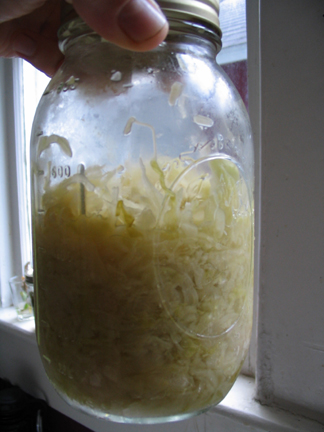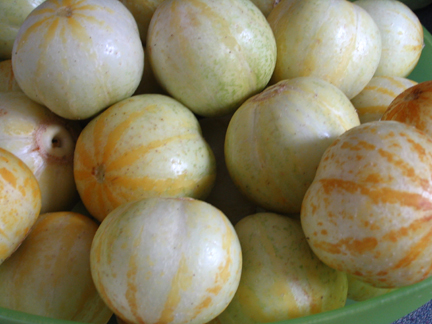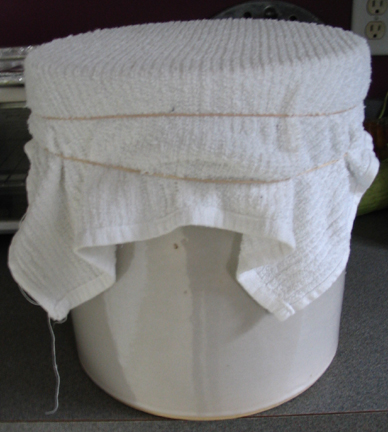Bread success – no knead sourdough
After discussing my bread problems on a previous post, I received quite a few helpful tips from readers and friends. El at Fast Grow the Weeds sent me a link to a no-knead bread recipe from the New York Times. The beauty of this recipe is that you let water and time do the work that your hands and back would usually do. Instead of using physical energy to create and expand the strands of gluten in the dough, the water (given eighteen or so hours) does the job for you.
I was skeptical, and, since I do not have packaged yeast, not convinced that I could make a sourdough no-knead loaf. I figured I would need a pretty strong and pretty watery starter to make everything work. After searching for no-knead sourdough recipes, I decanted a couple to try. This recipe is what worked for me.
Wait. First, a short discussion on my collection of sourdough starters…
This stuff is great if you take care of it. I use it a lot, and try many different flours in their creation and maintenance. I had three starters going, each with its own type of flour, but now I am down to two. If you don’t have a jar of starter and you make bread or pie or pancakes on a weekly basis then you are really missing out.
So I am down to two starters now. I was using graham flour in the one that died. It was getting pretty funky towards the end, losing its sweet aroma and leaning towards some kind of rotten smell. I don’t have a theory as to why the graham flour starter didn’t last. Maybe someone else has the answer. Here is the graham flour starter before I composted it:
It was pretty lifeless even after I fed it.
I also have a questionable starter that I feed whatever free flour I bring home from the store. It has recently eaten garbanzo bean flour, soy flour and a variety of other strange varieties.
It is still alive and smells fine. It does not bubble as much as my most active starter, the one I feed Southern Biscuit Flour, the only local flour I have available at the moment.
This one loves being what it is and performs no matter how long I neglect it or knock it around. It is my wild yeast workhorse, and I can’t praise it enough. I used this starter in the following recipe.
1 – Mix a sticky dough with three cups of flour, one cup of sourdough starter, one cup of water and one teaspoon of salt. You can also add just a dribble to honey to get everything real activated.
2 – Mix everything well, cover with plastic wrap and let sit for twelve to eighteen hours on your counter or other warm place. Sixty-eight degrees works well for mine, but seventy would be better.
3 – When the dough is ready it will have doubled its size (at least). Scoop the dough out onto a floured board.
4 – Form the dough into a ball, adding about a quarter cup more flour in the process. Don’t do too much work with the dough, just get it into a ball shape.
5 – Put the ball into a baking dish that has a cover. I am using a casserole dish at the moment, but have a cast iron Dutch Oven waiting to be put into service.
6 – Let the dough rise in the baking container. The recipes I found say everything from one to six hours. Use your best judgment.
7 – Place the baking dish (with cover) in a cold oven, set the temperature to 450 degrees and bake for one hour and ten minutes.
8 – Scrape the bread out of the container and set on a plate to cool.
Kristin says this is the best bread ever. It is really damn good.
Next up is Duncan’s beer bread…






December 18, 2007 at 5:20 pm
Wow – that looks fabulous. I’m envisioning some mini ones filled with butternut squash soup…mmmm.
July 26, 2008 at 7:19 pm
Help! I followed this recipe and instructions exactly (well, I did add about 1/3 cup flax seeds) and my final product looked nothing like yours. First, after 45 minutes i had to take it out of the oven because it smelled like it was burning. It was cooked all the way through and in fact had stuck to the bottom of the pan. Are you sure you don’t need to grease the pan before baking? Second, my loaf didn’t rise nearly as high as the picture of your loaf, or a loaf I would buy from a bakery. Was it the starter? My starter looked bubbly and alive so I’m not sure where I went wrong. Third, my dough was really sticky the whole time. Any ideas why mine came out so differently?
July 28, 2008 at 8:17 pm
Sandra:
Leave out the flax seeds for now. You might want to add a bit more flour to the mixture since it was overly sticky. Also, it sounds like it didn’t rise as much as it should have. Try the recipe with regular yeast and see if you have better results. The sourdough starter you have may need a lot more time to rise properly.
You can grease the bottom of the pan if need to be and adjust the baking time if needed. Unfortunately you will need to do some experimenting to get your setup to work for you. Hope this helps. Keep trying though!
August 13, 2008 at 7:06 pm
I had the same stickiness problem as Sandra. It did not rise the 2nd time. Is it possible to proof the dough too long the 1st time where the yeast in the starter dies? I proofed for 18 hours.
Thanks.
August 13, 2008 at 8:46 pm
The time frame shouldn’t be a problem as there is plenty of flour and water for the yeast. In theory the yeast will keep eating and get more sour.
The stickiness can be addressed by adding flour until it isn’t a problem, but be careful not to add too much. The dough ball will be somewhat sticky no matter what since you aren’t kneading it yourself and letting the water do the work.
November 1, 2008 at 11:07 am
Well, my starter like yours, is pretty amazing. It is ALIVE!! First time I tried this bread, I used whole wheat flour. AND I didn’t have a dutch oven, so I put it on a pizza stone and baked it that way. It turned out ok, but was very dense!! Sooooooooo this last time, I followed everything exactly! It only took 3 hours for my first rising, and then I added 1/4 cup more flour, and again…. it almost tripled in 3 hours!! (I live in the desert and it is warm here). So this time I had put it into an oiled pyrex baking dish, but it rose so high the lid wouldn’t fit. I covered it with foil and baked it as per your instructions. The bread turned out beautifully! It has an interesting texture. Probably because it trippled instead of doubled! It makes fabulous toast! Thanks! I’ll keep playing with this thing! All starters are different. That could be the key to success. Mine was started in Denver, and I sneaked it home in my luggage. It is truly bubbly and hungry! It loves every feeding!! Thanks for your great website!
Pingback: A Fabulous Collection Of Easy Southern Recipes. | 7Wins.eu
May 7, 2009 at 4:54 pm
Great recipe – worked perfectly the first time, almost rose too high (next time I will slash the top). Tip for sticking – I let mine second rise on greased parchment, and lowered the bread on the parchment into the pre-heated dutch oven. Came out fine.
May 24, 2009 at 1:14 pm
I’ve been practicing with this method a bit and have found out some things that may help others. My starter was not sour enough so I did the “handful of grapes” thing where you mash them and mixed them with some starter and extra de-chlorinated water. After a day I strained this goop thru a colander and added this souped up mix to my existing starter along with the next flour/water addition. This really got things going!
I feed my starter daily, never discarding any and keep it in a huge Tupperware bowl with a lid. Over several days I eventually have about a gallon of goo that’s all bubbly and sour. I take about a cup away, feed it and put it in the fridge for the next batch. The remainder becomes my bread with just the addition of a cup of powdered milk, some salt and approximately 3 cups of high gluten flour. (I use a product called “Bouncer”.) It gets mixed in the big bowl, rises for about 12 hours because of the high yeast content and then I divide it into two loaves. Seems one loaf is never enough for all the time and effort and it freezes well. I use a knife and a spatula to cut and separate the ‘mass’. I try not to get my hands into it until I’m flattening. I do the 1/3 then 1/2 fold and then sort of pinch off the seams and shape it into a nice ball.
I prepare my pots before I divide my dough for the final rise. I rub solid shortening all over the inside of a club aluminum dutch oven and a large 5 qt corning casserole. I then add a generous 1/3 cup of cornmeal and roll the pans until they are well coated. I find that the cornmeal acts like little ball bearings and helps the loaf release very well from the pan.
This dough is very goopy and floppy to work with but gives me the big holes and sour taste we love. Oh, and I scrape the bench flour off the counter top that is left after I get the dough into the pans and I add that bench flour to my starter. It has bits of dough and ‘stuff’ in it that just goes right back into the starter. I never waste any of my starter or flour, just keep adding it back in.
Hope this helps anyone who is enjoying making sourdough at home from scratch.
January 10, 2010 at 7:08 pm
I am a newbie at sourdough and have made it my mission to learn I made my starter from unbleached bread flour. I had to leave it near my heater vent because of the massive temperature fluctuations in my house (long story), and it never gets over 100 degrees. It looked like it was great after only 1 day, bubbly and beer-y smelling, so I went ahead and made my first attempt. I used 1 cup of the starter and 3 cups bread flour, 1 cup water and 1 tsp salt, kneaded it in my mixer and let sit for about 18 hours. It seemed to (maybe) almost double. I then took it and formed into a ball, but it seemed to have fallen a bit. Step 4 confused me, it said put on a floured board and dont work it too much, just form into a ball, but add about 1/4 cup flour.. is that the flour on the board, or should i have added an extra 1/4 c and worked it in? It seemed that by doing so, I would be working the dough too much. I only used 1/4 c to flour my board and worked that in a little bit (mainly on the outside though), maybe that is why it didnt rise on the 2nd rising? It is still very flat looking, but I went ahead and put in the oven. I have a feeling this try is going to be a failure
I made my starter from unbleached bread flour. I had to leave it near my heater vent because of the massive temperature fluctuations in my house (long story), and it never gets over 100 degrees. It looked like it was great after only 1 day, bubbly and beer-y smelling, so I went ahead and made my first attempt. I used 1 cup of the starter and 3 cups bread flour, 1 cup water and 1 tsp salt, kneaded it in my mixer and let sit for about 18 hours. It seemed to (maybe) almost double. I then took it and formed into a ball, but it seemed to have fallen a bit. Step 4 confused me, it said put on a floured board and dont work it too much, just form into a ball, but add about 1/4 cup flour.. is that the flour on the board, or should i have added an extra 1/4 c and worked it in? It seemed that by doing so, I would be working the dough too much. I only used 1/4 c to flour my board and worked that in a little bit (mainly on the outside though), maybe that is why it didnt rise on the 2nd rising? It is still very flat looking, but I went ahead and put in the oven. I have a feeling this try is going to be a failure  I kept the rest of the starter, so hopefully I can work with that in a few days. I have a few questions in the meantime:
I kept the rest of the starter, so hopefully I can work with that in a few days. I have a few questions in the meantime:
The posting above said she feeds her starter every day… how much? and what? I know when i begin my starter, it said leave it out of the fridge… how do I know at what point i put it in the fridge? Also, most things i have read regarding a starter say to cut it in half every 24 hours, and add 1/2 c flour and 1/2 c water. Would it not stand to reason, if I want to make a larger batch of starter, and not waste any of it, just add 1c each of flour and water? I dont understand why you would want to throw out half of it each day (I am a very thrifty person, dont like to throw out useable food!). I dont have a compost bin, and it seems a waste to dump it down the drain. Also, if you see that your dough has not risen enough, is there anything you can do to help it rise or is it just a worthless cause? I have seen recipes state that it can take anywhere from 1 – 18 hours or more to rise, so i am a bit lost as to when i should just chuck it and start over. Sorry for the questions and confusion, but as I said I am a COMPLETE beginner. For now, I am assuming that I rushed using my starter even though it looked/smelled ready, and possibly did not add enough flour for the 2nd rise. Thanks for any help!
July 29, 2010 at 2:02 am
I best like to no knead recipe as I like my bread to be soft and light. First I mix 2 cups of starter with one cup of flour and a little salt, no water added as my starter is watery. I mix it in a baking bowl with a spoon until is combined. This makes the dough soft and sticky but I do not want to add any more flour and knead it by hand as it would become too hard. I leave it overnight for about 20 hours or so until it at least doubles in size, usually it is two nights all together. Than I bake it in the same bowl without moving it, wiht a lid, and uncover it after half an hour to crisp the top. The moisture in the bread with help of the lid keeps it soft and gives nice crust.
So try it yourself, as easy as 1, 2, 3.